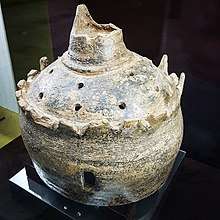Bidaa Bint Saud

Bidaa Bint Saud is an archaeological site in Al Ain, United Arab Emirates, notable for its Hafit Period tombs, Iron Age irrigation systems and rare remains of an Iron Age building thought to have been a distribution centre for water from two aflaj. It is a listed UN World Heritage site.[1][2] Finds from the site are displayed at the Al Ain National Museum.[3]
The dating of pottery from the falaj irrigation systems found at the site demonstrates a south-eastern Arabian origin for this distinctive system of irrigation,[4] previously thought by many scholars to have been Persian (Qanat) in origin.[5][1] The dating of aflaj in Al Ain, Buraimi and Bidaa bint Saud has been placed several centuries prior to the Achemanean Empire, which had previously been credited with the innovation.[6]
The site, located some 15 kilometres north of Al Ain, is thought to have been a stopping place on a long-established caravan route from settlements at Al Ain to the Northern Emirates. The rocky outcrop of Garn bin Saud looms some 40 metres above the site and is dotted with burial remains.

Bronze Age tombs
A number of distinctive Hafit Period (3200 to 2600 BCE) tombs litter the eastern face of Garn bint Saud, similar to those found at sites such as Jebel Hafit, Jebel Al-Buhais and Buraimi. These have collapsed and would originally have had domed roofs. It is likely the location of the Hafit remains, the Hafit people being nomadic and pastoral, is because of a source of groundwater, a pattern supported by other Hafit era inland finds, including those at Jebel Hafit and Jebel Al-Buhais.[7]
Iron Age waterways

A second set of collective graves found at the site dated from the Iron Age and were also built of uncut or rough-cut stone and formed into a variety of shapes. These were divided into several chambers, each of which contained the remains of several people. Despite having been plundered in the past, excavations from these Iron Age tombs yielded a number of artefacts, including pottery and stone vessels, dagger blades, bronze arrowheads, and beads.[1] It is thought Bidaa Bint Saud became an important site during the Iron Age, both as a caravan stop and as settled community of farmers that used the falaj irrigation system.[8]
Two of these irrigation passages have been partly excavated at Bidaa bin Saud, with a number of sections remaining in reasonable condition. In one of the excavations, a number of sandstone-lined shaft holes were discovered, as well as a stepped underground access point and a large open cistern. Evidence of formerly irrigated land has also been found at the site.[6]
The mother well is thought to have been relatively shallow, some 1km away from the head of the falaj systems.[9]
Located some 150 metres from the main access point of the falaj, archaeologists have also excavated a large mud-brick building containing a large hall of 10 x 13 metres. Parts of the remains stand up to 160 centimetres high and, while the roof is missing, there is evidence it was supported by 12 columns. Storage rooms were a later addition and contained finds of many storage jars. While the building's precise purpose remains unclear, archaeologists think it was likely a distribution point for the water from the falaj systems[9] and it has been dubbed Bait Al Falaj or 'house of the falaj'.[8]
See also
References
- 1 2 3 "Bidaa Bint Saud". Abu Dhabi Culture. 2018-02-11. Retrieved 2018-07-31.
- ↑ "Al Ain wins World Heritage List honours". The National. Retrieved 2018-07-31.
- ↑ "Al Ain National Museum". www.abudhabi.ae. Retrieved 2018-07-31.
- ↑ Kazmi, Aftab (2003-03-16). "New evidence shows falaj in Al Ain is world's oldest". GulfNews. Retrieved 2018-07-31.
- ↑ TIKRITI, WALID YASIN AL (2002). "The south-east Arabian origin of the falaj system". Proceedings of the Seminar for Arabian Studies. 32: 117–138.
- 1 2 Underground aqueducts handbook. Angelakis, Andreas N. (Andreas Nikolaos),, Chiotis, Eustathios,, Eslamian, Saeid,, Weingartner, Herbert,. Boca Raton. ISBN 9781315368566. OCLC 966358839.
- ↑ Oases and globalization : ruptures and continuities. Lavie, Emilie,, Marshall, Anaïs,. Cham, Switzerland. p. 65. ISBN 9783319507491. OCLC 979992085.
- 1 2 Editor, Samir Salama, Associate (2011-12-30). "Al Ain bears evidence of a culture's ability to adapt". GulfNews. Retrieved 2018-07-31.
- 1 2 Archaeology of the United Arab Emirates. Potts, Daniel T.,, Nābūdah, Ḥasan Muḥammad,, Hellyer, Peter,. London. ISBN 190072488X. OCLC 54405078.